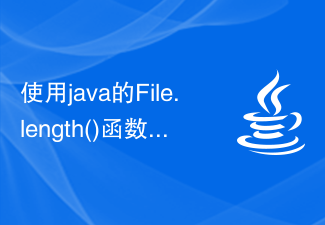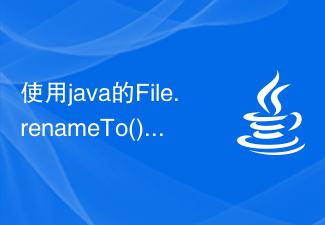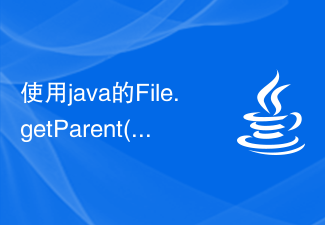PHP开发笔记系列(四)-文件操作
??? 对于一般的web应用程序,数据会保存在数据库表中,但是文件操作也是必须的,例如文件的读取、写入等,典型的应用场景是考试报名,当系统启动时,自动读取“报名须知”的内容到内存中,然后再需要时显示到页面当中。这次本文《PHP开发笔记系列(四)-文件操作》将研究一下PHP中的文件操作。
?
1. 读取文件到数组(file)
??? file()函数可以将文件按行读取到一个字符串数组中,后续程序可以通过遍历这个字符串数组来做处理。
file:file.phpurl:http://localhost:88/file/file.php<?php $file = file(basename(__FILE__)); $lines = count($file); for($i=0; $i<$lines; $i++){ $color = ($i%2==0) ? 'red' : 'white'; echo '<div style="background-color: '.$color.'">'; echo $i.':'.htmlspecialchars($file[$i]); echo '</div>'; }?>?2. 读取文件到字符串(file_get_contents)
??? file_get_contents()函数可以将文件中的所有内容读取到一个字符串变量中,后续程序可以将这个字符串中的内容显示在页面,或者写入到新文件当中。
file:file_get_contents.phpurl:http://localhost:88/file/readfile.php<?php $file = file_get_contents('file.html'); $file = strip_tags($file); echo '<form><textarea rows=12 cols=80>'.htmlspecialchars($file).'</textarea></form>';?>?
3. 读取文件到屏幕(readfile)
??? readfile()函数直接读取文件内容并回显到屏幕,上传或下载时也会用到这个函数。
file:readfile.phpurl:http://localhost:88/file/readfile.php<?php readfile('file.html');?>?
??? 上面的方法只能全部或按照新行符读取文件中的内容,读到数组或字符串或屏幕中,然后如果需要更加灵活的读取文件内容或写文件内容,就需要用到文件句柄了,类似于C语言当中的文件读写函数。
4. 一次读取整个文件内容(fread、filesize)
??? 对于文件的大小相对比较小的文件,可以一次将整个文件的内容读取到内存当中。步骤是,1)fopen打开新文件,并指定使用模式,2)使用fread按照指定的长度读取文件内容,3)fclose关闭句柄。
file:fread.phpurl:http://localhost:88/file/fread.php<?php $location = 'file.html'; $file = fopen($location, "rb"); $fileContent = fread($file, filesize($location)); fclose($file); echo $fileContent;?>?
5. 分次读取整个文件的内容(fgets、feof)
??? fgets函数可以分片获取文件的中内容,feof可以判断文件是否已经读取到末尾。
file:fgets.phpurl:http://localhost:88/file/fgets.php<?php $location = 'file.html'; $fp = fopen($location, 'rb'); while(!feof($fp)){ $chunk = fgets($fp); echo $chunk; } fclose($fp);?>?
6. 一次读取(file_get_contents),一次写入(file_put_contents)
??? 有时候对于小文件读取和写入,可以方便的使用file_get_contents()和file_put_contents()方法进行写入,无需创建文件句柄。
file:readOnce_writeOnce.phpurl:http://localhost:88/file/readOnce_writeOnce.php<?php $source = 'file.html'; $destination1 = 'readOnce_writeOnce.html'; // 一次读取,一次写入 $sourceContent = file_get_contents($source); file_put_contents($destination1, $sourceContent);?>
?
7. 分行读取,分行写入(fwrite)
??? 对于大文件的读取和写入,如果一次load到内容,很有可能导致内存溢出或web服务器宕机,因此需要采用逐行读取逐行写入。可以使用file()行数将源文件读取到一个字符串数组中,然后通过fwrite逐行写入目标文件,当然,需要使用fopen打开句柄,写入结束后使用fclose关闭句柄。
file:multiRead_multiWrite.phpurl:http://localhost:88/file/multiRead_multiWrite.php<?php $source = 'file.html'; $destination2 = 'multiRead_multiWrite.html'; $lines = file($source); $fp = fopen($destination2, 'w'); foreach ($lines as $line) { fwrite($fp, $line); } fclose($fp);?>?8. 其他文件处理函数
file:other.phpurl:http://localhost:88/file/other.php<?php $fileName = basename(__FILE__); $dirPath = './'; // file_exists()返回1 或 0 echo $fileName.': '.file_exists($fileName).'<br/>'; // is_file()返回1 或 0 echo $fileName.' is '.is_file($fileName)?'file':'directory'.'!'.'<br/>'; // is_readable()返回1 或 0 echo $fileName.' readable:'.is_readable($fileName).'<br/>'; // is_writable()返回1 或 0 echo $fileName.' writable:'.is_writable($fileName).'<br/>'; echo $fileName.' created at:'.filemtime($fileName).'<br/>'; echo $fileName.' created at:'.fileatime($fileName).'<br/>'; echo $fileName.' size:'.filesize($fileName).'<br/>';?>
?
?
9. 目录读取(opendire、readdir、closedir)
??? 第一种方法,使用opendir、readdir、closedir函数进行目录的打开、读取、关闭,类似于文件的fopen、fread、fclose,代码如下:
file:dir.phpurl:http://localhost:88/file/dir.php<?php $location = './'; $dp = opendir($location); while ($entry = readdir($dp)){ if(is_dir($entry)) { echo '[DIR] '.$entry. '<br/>'; }elseif (is_file($entry)) { echo '[FILE] '.$entry. '<br/>'; } } closedir($dp);?>?
??? 第二种方法,采用php提供的面向对象的dir类,通过传入一个目录路径来构造一个dir实例,再通过实例的read方法进行目录读取,代码如下:
file:dir-class.phpurl:http://localhost:88/file/dir-class.php<?php $location = './'; $dir = dir($location); while ($entry = $dir->read()){ if(is_dir($entry)) { echo '[DIR] '.$entry. '<br/>'; }elseif (is_file($entry)) { echo '[FILE] '.$entry. '<br/>'; } } closedir($dp);?>?10. 文件拷贝(copy)
file:copy.phpurl:http://localhost:88/file/copy.php<?php $source = 'file.html'; $dest = 'file-copy.html'; copy($source, $dest);?>
?
?
11. 文件移动、重命名(rename)
<?php $source = 'file-copy.html'; $dest = 'file-copy-1.html'; rename($source, $dest);?>
?
??? 本文地址:http://ryan-d.iteye.com/blog/1543374
 鸿蒙原生应用随机诗词Feb 19, 2024 pm 01:36 PM
鸿蒙原生应用随机诗词Feb 19, 2024 pm 01:36 PM想了解更多关于开源的内容,请访问:51CTO鸿蒙开发者社区https://ost.51cto.com运行环境DAYU200:4.0.10.16SDK:4.0.10.15IDE:4.0.600一、创建应用点击File->newFile->CreateProgect。选择模版:【OpenHarmony】EmptyAbility:填写项目名,shici,应用包名com.nut.shici,应用存储位置XXX(不要有中文,特殊字符,空格)。CompileSDK10,Model:Stage。Device
 php怎么把负数转为正整数Apr 19, 2022 pm 08:59 PM
php怎么把负数转为正整数Apr 19, 2022 pm 08:59 PMphp把负数转为正整数的方法:1、使用abs()函数将负数转为正数,使用intval()函数对正数取整,转为正整数,语法“intval(abs($number))”;2、利用“~”位运算符将负数取反加一,语法“~$number + 1”。
 使用java的File.length()函数获取文件的大小Jul 24, 2023 am 08:36 AM
使用java的File.length()函数获取文件的大小Jul 24, 2023 am 08:36 AM使用Java的File.length()函数获取文件的大小文件大小是在处理文件操作时很常见的一个需求,Java提供了一个很方便的方法来获取文件的大小,即使用File类的length()方法。本文将介绍如何使用该方法来获取文件的大小,并给出相应的代码示例。首先,我们需要创建一个File对象来表示我们想要获取大小的文件。以下是创建File对象的方法:Filef
 php blob怎么转fileMar 16, 2023 am 10:47 AM
php blob怎么转fileMar 16, 2023 am 10:47 AMphp blob转file的方法:1、创建一个php示例文件;2、通过“function blobToFile(blob) {return new File([blob], 'screenshot.png', { type: 'image/jpeg' })}”方法实现Blob转File即可。
 使用java的File.renameTo()函数重命名文件Jul 25, 2023 pm 03:45 PM
使用java的File.renameTo()函数重命名文件Jul 25, 2023 pm 03:45 PM使用Java的File.renameTo()函数重命名文件在Java编程中,我们经常需要对文件进行重命名的操作。Java提供了File类来处理文件操作,其中的renameTo()函数可以方便地重命名文件。本文将介绍如何使用Java的File.renameTo()函数来重命名文件,并提供相应的代码示例。File.renameTo()函数是File类的一个方法,
 使用java的File.getParentFile()函数获取文件的父目录Jul 27, 2023 am 11:45 AM
使用java的File.getParentFile()函数获取文件的父目录Jul 27, 2023 am 11:45 AM使用java的File.getParentFile()函数获取文件的父目录在Java编程中,我们经常需要操作文件和文件夹。当我们需要获取文件的父目录时,可以使用Java提供的File.getParentFile()函数来完成。本文将介绍如何使用这个函数并提供代码示例。Java中的File类是用于操作文件和文件夹的主要类。它提供了许多方法来获取和操作文件的属性
 php怎么判断有没有小数点Apr 20, 2022 pm 08:12 PM
php怎么判断有没有小数点Apr 20, 2022 pm 08:12 PMphp判断有没有小数点的方法:1、使用“strpos(数字字符串,'.')”语法,如果返回小数点在字符串中第一次出现的位置,则有小数点;2、使用“strrpos(数字字符串,'.')”语句,如果返回小数点在字符串中最后一次出现的位置,则有。
 使用java的File.getParent()函数获取文件的父路径Jul 24, 2023 pm 01:40 PM
使用java的File.getParent()函数获取文件的父路径Jul 24, 2023 pm 01:40 PM使用java的File.getParent()函数获取文件的父路径在Java编程中,我们经常需要操作文件和文件夹。有时候,我们需要获取一个文件的父路径,也就是该文件所在文件夹的路径。Java的File类提供了getParent()方法用于获取文件或文件夹的父路径。File类是Java对文件和文件夹的抽象表示,它提供了一系列操作文件和文件夹的方法。其中,get


핫 AI 도구

Undresser.AI Undress
사실적인 누드 사진을 만들기 위한 AI 기반 앱

AI Clothes Remover
사진에서 옷을 제거하는 온라인 AI 도구입니다.

Undress AI Tool
무료로 이미지를 벗다

Clothoff.io
AI 옷 제거제

AI Hentai Generator
AI Hentai를 무료로 생성하십시오.

인기 기사

뜨거운 도구

SublimeText3 영어 버전
권장 사항: Win 버전, 코드 프롬프트 지원!

SublimeText3 중국어 버전
중국어 버전, 사용하기 매우 쉽습니다.

WebStorm Mac 버전
유용한 JavaScript 개발 도구

SublimeText3 Mac 버전
신 수준의 코드 편집 소프트웨어(SublimeText3)

SublimeText3 Linux 새 버전
SublimeText3 Linux 최신 버전

뜨거운 주제
 1374
1374 52
52 39
39 19
19


